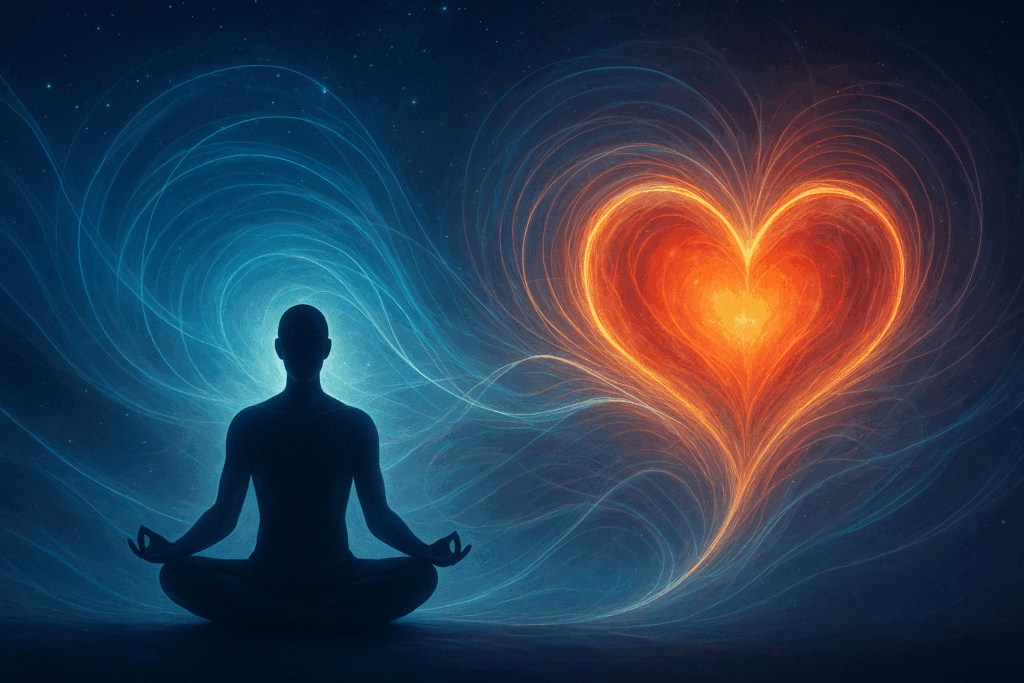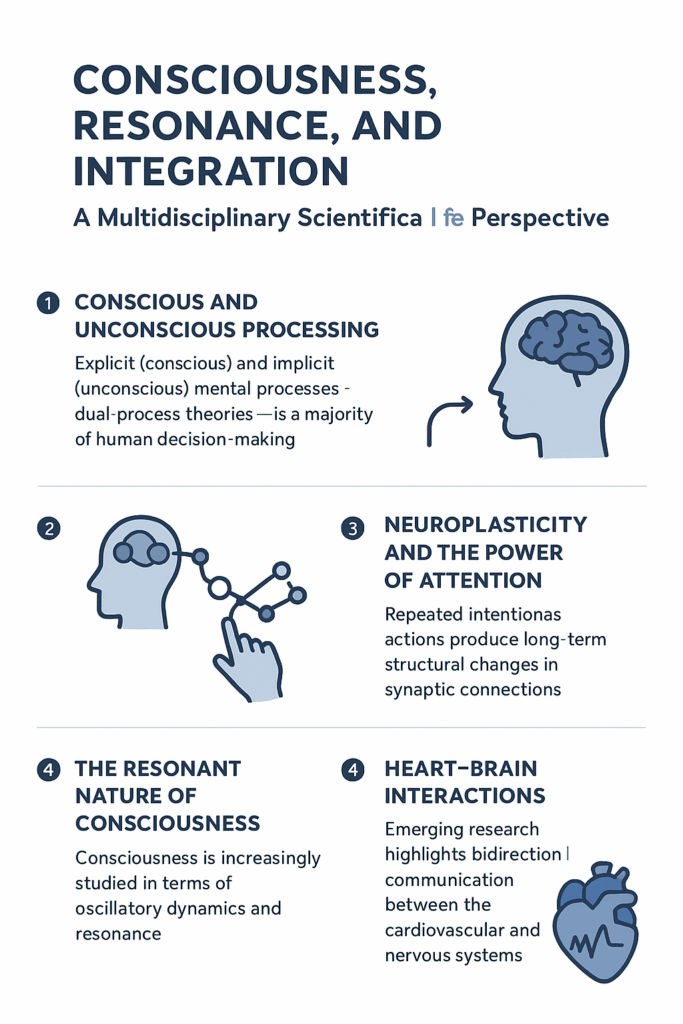Consciousness, Resonance, and Integration: A Multidisciplinary Scientific Perspective
Abstract
Consciousness remains one of the most complex and debated phenomena in science. Contemporary research increasingly recognizes the interplay between conscious and unconscious processes, the vibrational dynamics of neural and physical systems, and the role of embodied factors such as heart-brain interactions. This article reviews current perspectives from neuroscience, physics, and psychology on three interconnected questions: (1) the division between surface and deep mind, (2) the vibrational and resonant nature of consciousness, and (3) the integration of self-experience toward states of coherence and transcendence.

1. Conscious and Unconscious Processing
Modern cognitive science distinguishes between explicit (conscious) and implicit (unconscious) mental processes.
- Dual-process theories (Evans & Stanovich, 2013) describe fast, automatic, intuitive processes (System 1) alongside slower, deliberate, reflective reasoning (System 2).
- Neuroscience estimates that the majority of human decision-making—up to 95%—is driven by unconscious processes (Kihlstrom, 1987).
- The unconscious regulates not only bodily functions but also higher-order behaviors, with conscious thought often retroactively rationalizing outcomes already influenced by deeper mechanisms.
This suggests that consciousness is more a selective spotlight than a global controller.
2. Neuroplasticity and the Power of Attention
Despite the dominance of unconscious processing, conscious activity shapes the brain through neuroplasticity.
- Repeated intentional actions (e.g., meditation, cognitive reframing, skill learning) produce long-term structural changes in synaptic connections (Draganski et al., 2004).
- Attention acts as a causal force in modulating neural networks, allowing conscious processes to influence subconscious decision architectures over time.
Thus, even though the unconscious is vast, deliberate awareness can gradually reshape its patterns.
3. The Resonant Nature of Consciousness
Consciousness has increasingly been studied in terms of oscillatory dynamics and resonance.
- Neural activity occurs in rhythmic patterns: delta (0.5–4 Hz), theta (4–8 Hz), alpha (8–12 Hz), beta (12–30 Hz), and gamma (>30 Hz) oscillations. Different states of awareness correlate with characteristic frequency profiles (Buzsáki & Draguhn, 2004).
- Coherent oscillations across brain regions appear crucial for integrative conscious states, leading to theories such as the Global Neuronal Workspace (Dehaene, 2011) and Integrated Information Theory (Tononi, 2014).
- Beyond neuroscience, vibrational paradigms in physics (quantum field excitations, wave-particle duality) offer metaphoric and potentially literal frameworks for understanding reality as frequency-based phenomena.
Consciousness may thus be viewed as an emergent property of resonant synchronization.
4. Heart–Brain Interactions
Emerging research highlights the bidirectional communication between the cardiovascular and nervous systems.
- The heart possesses an intrinsic nervous system of ~40,000 neurons, sometimes termed the “heart-brain” (Armour, 1991).
- The vagus nerve mediates continuous feedback between cardiac rhythms and cortical centers. Heart rate variability (HRV) coherence has been associated with emotional stability, resilience, and increased access to intuitive processing (McCraty & Childre, 2010).
- Psychophysiological coherence practices (e.g., heart-focused meditation) have been shown to enhance frontal-limbic regulation, supporting compassion and well-being.
This convergence suggests that consciousness cannot be fully understood without accounting for embodied physiological networks.
5. Temporal Perception and Eternity
Subjective time diverges significantly from physical time.
- Relativity theory demonstrates that time is relative to observers and may exist as part of a four-dimensional “block universe” where all events coexist.
- Neuroscience reveals that temporal perception is strongly modulated by attention, emotional state, and altered consciousness. Flow states and meditation often produce experiences of “timelessness” (Wittmann, 2018).
- These findings suggest that while physics describes time as a dimension, phenomenology reveals time as a flexible and emergent property of consciousness.
6. Toward Integration and Self-Transcendence
A growing field of transpersonal psychology explores self-transcendence, in which ego-centered consciousness gives way to expanded awareness.
- Neuroimaging studies of contemplative practitioners show decreased activity in the default mode network (DMN)—associated with self-referential thought—and increased global coherence across distributed brain regions (Brewer et al., 2011).
- These changes correlate with reported experiences of unity, compassion, and connection to a larger whole.
- From a systems perspective, such states may represent an emergent integration of mind, body, and environment through resonance and coherence.
Conclusion
Current science suggests that consciousness is not confined to isolated egoic processes but emerges from the dynamic interplay of neural oscillations, unconscious regulation, embodied networks, and relational integration. The convergence of neuroscience, physics, and psychology supports a view of consciousness as a resonant and integrative phenomenon, capable of transcending narrow self-identification and opening into states of coherence that reshape both perception and physiology.

